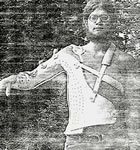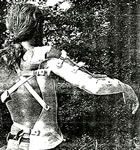I feel like Theseus standing on the edge of the Labyrinth, here, clutching one end of a thread leading off into intricacy. Large issues, these: where to begin?
One parallel presents itself: osteopathy deals with the whole man, the inter-relationship of all his parts. The community is composed of all its individual members and their inter-relationships. Each is the sum total of its parts. In each, the health of the whole depends on the health and harmony of its components. An examination of these inter-relationships will be a focal point of this essay.
A step further into the maze: what is osteopathy?
"A form of medical treatment purporting to cure a wide variety of diseases primarily by manipulation of the joints of the body" ? (1)
"A method of diagnosis and treatment that lays especial emphasis on the body's structural and mechanical problems" ? (2)
"An approach ... whose objective is the complete restoration of the structural integrity in the body" ? (3)
So much for the learned terms. The big question is: "Does it work?"
My own respect for osteopathy is immediate and compelling. After meeting a drunken driver head-on on the motorway in 1973, I spent three years and six operations having my arms re-assembled, assured by the genial surgeon that I would never use them again. ("Robin, you have what we call 'Humpty-Dumpty breaks'.")
 |
I was to spend several months wearing these casts following the collision |
 |
Two decades of grinding effort and vile temper later, I use these same arms to make my living as a yoga instructor and massage therapist; to power me through my recreations of gymnastics and martial arts, bouncing off the floor over and over and over. Still, the lopsided remake is not always up to the original, and sometimes the body is clearly and painfully thrown off balance: an immobilised neck; an agonised lower back; slowly flattening feet.
My friend John-the art-tutor had the answer, as always: "See my osteopath! Did wonders for my neck; a couple of sessions and it's like new - or better".
Years later, my regular apointment is a lighthouse in a tossing sea. Past crises resolved, dramatic improvements, and real insights given into maintenance of the damaged body. ("Anyone would say you're mad to do handsprings on that shoulder, but if that's what you want to do ... do lots and lots of warm-ups first".)
Osteopathy has worked for me, and is constantly receiving referrals from my massage practice ("and if you can't afford him,try the student clinic at the British School of Osteopathy.")
Next? Community. (Our thread rounds a corner, here.) Various descriptions may apply, from the prosaic:
"a body of people living near one another and in social relationships". (4)
to the passionate:
"Community ... people living together in both freedom and love". (5)
"In and through community lies the salvation of the world". (6)
In the vast sprawl of London-Town, my local community of these last several years, "freedom" and "love" are not the first descriptions that spring to mind; and sometimes the idea of any social relationship at all seems strained. (A quick scan of the daily headlines can have this effect.)
In a metropolis of some eight million, one forges one's own circuit. Just like in a jungle, one developes well-beaten paths, work to recreation to watering hole; and along the way forms bonds with those moving in the same rhythms, so developing such overlapping entities as the artistic community, the business community, the therapeutic community.
In the 1990's, common aspiration carries more weight than geographic proximity in creating a sense of community.
Washed up on these wintry shores some six years ago knowingnot a soul, finding my way into my present community has been an evolutionary process. Its matrix is the therapeutic work done as a yoga instructor and as a massage therapist which full social contact unfolds. This traverses all levels of age and health, from top athletes through businessmen, actors, musicians, to those wheelchair confined, or mentally handicapped, some beyond speech or continence.
My community covers a wider spectrum of the human condition than many are privileged to know.
And finally, the unwinding thread of Theseus moves into the home stretch: "the 1990's" - our brave new world, that hath such creatures in it.
What is different in the 1990's? How are things changing? What trends are perceptible in the health-care community?
One trend is the increasing awareness of the importance of taking responsibility for one’s own health. “An ounce of prevention is worth a pound of cure”, as my dear old Dad used to say. (“A tidy ship is a happy ship” was popular, too.)
Proper diet and adequate exercise are replacing the attitude of” that’s the doctor’s concern”. As people grow in this habit, enjoying the positive results, they become increasingly ready to benefit from other complementary health-care modes.
Osteopathy is a logical complement to established Western medical practice. In a society where e estimated 22 million people suffer from back pain each year, losing nearly 50 million working days (6) there is clearly room for new input.
When all else fails, we may resort to common sense:
A physical, hands-on approach to a physical problem. “Structure governs function””; (7) examine and correct the structure in order to improve the function. The temple of the spirit sometimes needs its underpinnings examined.
Another plus for osteopathy in the 1990’s is its side-effects: none. A drug-free, hands-on treatment, in which no forceful manipulations are involved, ha a strong appeal to a generation that grew up with the Thalidomide children. The osteopath, trained to work with the total picture of the client’s health, has a large repertoire of technique to draw upon in responding to a given situation, trying to determine and treat the cause of a condition rather than merely suppressing its effects. Once the integrity of the body is restored, the natural healing processes can fulfil their function.
Word-of-mouth, old as the hills, remains the most effective promotion. Nothing fosters enthusiasm as strongly as the relief of pain; converts to the benefits of osteopathy aren’t slow to spread the good word. A high success rate creates its own spotlight.
Although extremely impressive results are possible, of course not every situation can be totally resolved. There is today a growing awareness of learning how to live with a disability, minimising its negative side-effects. Here osteopathy again steps beyond the concept of a one-step cure-all: rather offering the possibility of regular maintenance sessions with a view to maintaining the optimum level of adjustment. (This, of course, is my own situation, with particular regard to the right shoulder
One sector of community moving into new prominence in the ‘90‘s is very close to my heart: our handicapped citizens. Previously marginalised and neglected, the disabled are now using new resources such as motorised wheelchairs, head-set operated computers, and, significantly. Political organisation, to reach out into the world and make their voices heard.
Osteopathy can play a large role in reducing the limitations imposed by each particular condition, helping to reach the maximum adjustment and freedom possible.
To project slightly into the future: perhaps the concept of ’preventative clinics’ may become established, with a public acceptance of the concept of examination and possible correction before damage occurs.
The thread that we’ve been patiently tracing throughout this paper now moves into a new chamber. The 1990’s mark a new acknowledgement of the power that the state of emotional health exerts over the physical condition. It is a cliché that here at the tail-end of the hyper-paced 20th Century, tension is a killer. To ice the cake, we are conditioned to politely repress any awkward signs of stress; and all around us witness the muted explosions of overload.
To coin a phrase, perhaps a penny invested in prevention is worth a pound of cure. Can we learn to take care of ourselves before we crack up? To cope with stress without resorting to chemical tranquillisers?
Speculation gains substance here, when I witness, through my own practise, the investment that hard-headed businessmen are willing to make in stress-reducing mechanisms. Even New Age businessmen run with one eye on the bottom line; it underlines the practicality of stress reduction to see management increasing its investment n proper healthcare; including, gradually, massage and osteopathy.
Western medicine is corroborating one of the fundamental principles of the ages-old yogic approach to total health: that the human is a complete being living on the three levels of body, mind and spirit, each affecting the other. Clearly visible when a physical injury drags down the spirits, the reverse is now gaining recognition: that repressed emotion can manifest in physical discomfort, whether it be poor digestion, migraine headaches, or clenched neck or back pain.
Here the holistic approach of the osteopath can once again serve both in treating the condition and in discerning and treating the cause.
The ‘hands-on’ approach is in itself a valuable therapy, especially in a society in which the members are used to physical contact only in the form of sex or violence. There is a tremendous relief, a potent form of psychotherapy, in a sensitive, skilled laying on of hands. There is substance in the old phrase: ‘the hands of a healer’. |
